
Mount Vernon is a neighborhood of Baltimore, Maryland, located immediately north of the city's downtown district. Designated a city Cultural District, it is one of the oldest neighborhoods originally home to the city's wealthiest and most fashionable families. The name derives from Mount Vernon, the home of George Washington, given the original Washington Monument, a massive pillar commenced in 1815 to commemorate the first president of the United States, is the defining feature of the neighborhood.

The Dunbar Apartments, also known as the Paul Laurence Dunbar Garden Apartments or Dunbar Garden Apartments, is a complex of buildings located on West 149th and West 150th Streets between Frederick Douglass Boulevard/Macombs Place and Adam Clayton Powell Jr. Boulevard in the Harlem neighborhood of Manhattan, New York City. They were built by John D. Rockefeller Jr. from 1926 to 1928 to provide housing for African Americans, and was the first large cooperative aimed at that demographic. The buildings were designed by architect Andrew J. Thomas and were named in honor of the noted African American poet Paul Laurence Dunbar.

Mihran Mesrobian was an Armenian-American architect whose career spanned over fifty years and in several countries. Having received an education in the Academy of Fine Arts in Constantinople, Mesrobian began his career as an architect in Smyrna and in Constantinople. While in Constantinople, Mesrobian served as the palace architect to the last Ottoman Sultan, Mehmed V.
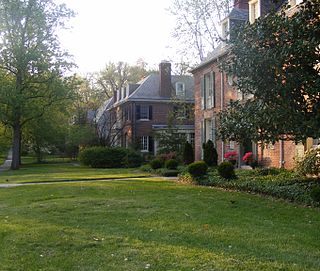
Guilford is a prominent and historic neighborhood located in the northern part of Baltimore, Maryland. It is bounded on the south by University Parkway, on the west by North Charles Street, Warrenton and Linkwood Roads, on the north by Cold Spring Lane and on the east by York Road. The neighborhood is adjacent to the neighborhoods of Tuscany-Canterbury, Loyola-Notre Dame, Kernewood, Wilson Park, Pen Lucy, Waverly Oakenshawe, Charles Village, and the universities of Johns Hopkins and Loyola University Maryland. The neighborhood was added to the National Register of Historic Places in 2001.

Ednor Gardens-Lakeside is a large community in northeast Baltimore, Maryland. It is bounded by 33rd Street to the south, Hillen Road to the east, Ellerslie Avenue to the west, and Argonne Drive, The Alameda, Loch Raven Boulevard, and Roundhill Road to the north. Ednor Gardens was part of a large planned community that was built out from the 1920s through the 1950s by Edward Gallagher, one of Baltimore's most prolific homebuilders at the time. It is notable among its neighbors for the quality of the homes and extensive landscaping. Until it was torn down in 2002, Memorial Stadium was located in Ednor Gardens-Lakeside.

Seton Hill Historic District is a historic district in Baltimore, Maryland. It was listed on the National Register of Historic Places in 1975.

Hilltop Manor is an historic apartment complex located in Bladensburg, Prince George's County, Maryland. The complex consists of eight brick garden apartment buildings, each of which is divided into two to six units or sections, constructed in 1942 and 1943.
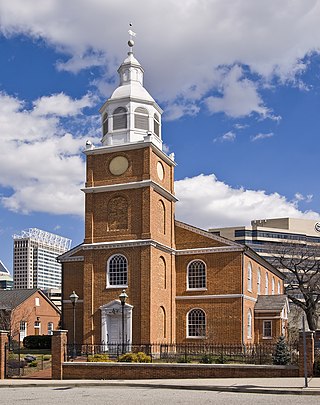
Otterbein Church, now known as Old Otterbein United Methodist Church, is a historic United Brethren church located in Baltimore, Maryland, United States. The first "German Reformed" church was built to serve the German Reformed and some Evangelical Lutheran immigrants, and later entered the Brethren strain of German Reformed Protestantism in the later Church of the United Brethren in Christ.

Public School No. 4 , also known as Columbus School, is a historic elementary school located at Baltimore, Maryland, United States. It is a two-story Romanesque Revival styled structure constructed in 1891 and expanded in 1905 and 1912. It features a three-story central square tower with pyramidal roof and a flanking pair of cylindrical corner towers with conical roofs. The structure was used as the South Clifton Park Community Center.
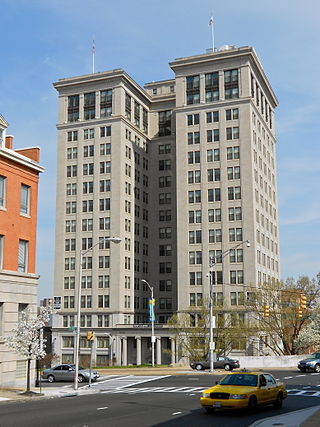
Standard Oil Building, also known as the Stanbalt Building, is a historic office building located at Baltimore, Maryland, United States. It is a 15-story Beaux Arts skyscraper designed by Clyde N. Friz (1867-1942), one of Baltimore's best-known Beaux Arts designers, and built in 1922. The steel-frame "U"-shaped office building is clad in limestone. It was built by the Standard Oil Company at a time when that business was once one of the nation's principal corporations, the dominant supplier of gasoline and fuels.
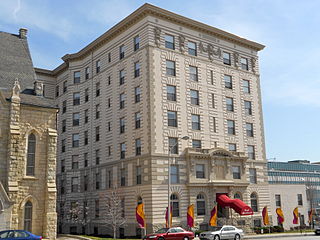
Cecil Apartments is a historic apartment building in Baltimore, Maryland, United States. It is a seven-story building constructed of multiple shades of light-colored brick, accented with limestone and cast terra cotta ornament in the Beaux-Arts style. The structure takes the form of a "T". Constructed in 1902, it was one of the first important apartment buildings in Baltimore, built at the edge of the city's most elite downtown neighborhood, Bolton Hill. It was designed by Baltimore architect Edward Hughes Glidden, and it marked the evolution of elite living that had come to characterize the Bolton Hill neighborhood. Despite the apartments' location often being referred to as Bolton Hill, it is actually within the boundaries of the adjacent Madison Park neighborhood.

Home of the Friendless is a historic orphanage at Baltimore, Maryland, United States. It is a three bay wide, five story high Second Empire style brick building constructed in 1870 as an orphanage. The building provided a home for orphaned and deserted children for six decades and was part of a three-building complex that housed from 100 to 200 children each year. By 1922 the Board of Managers and Trustees had decided to sell the property and move to the suburbs. The institution is now known as Woodbourne Center.

Lake Drive Apartments is a historic apartment building located at Baltimore, Maryland, United States. It is an 8-story high-rise building, built in 1919–1920, and designed by prominent local architect Edward L. Palmer, Jr. in the Classical Revival style.
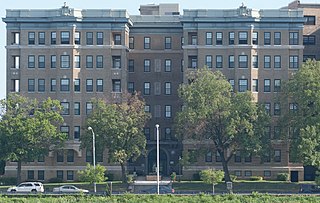
Riviera Apartments is a historic apartment building located at Baltimore, Maryland, United States. It is a six-story, brick and cast stone apartment building built in 1915.

Eutaw–Madison Apartment House Historic District is a national historic district in Baltimore, Maryland, United States. It consists of a group of three multi-story apartment buildings built in the first quarter of the 20th century. They are: The Esplanade, a 9-story apartment building built in 1912; the Emersonian, an 8-story building constructed in 1915 of stuccoed masonry; and Temple Gardens, a 14-story building built in 1926. The district is significant in part because of its association with Baltimore's Jewish community. During the 19th century, the Eutaw–Madison neighborhood became a center for the Jewish community in Baltimore. By the 1920s the neighborhood had been established firmly as a neighborhood of middle and upper-class Jews, many of whom were professionals and merchants.
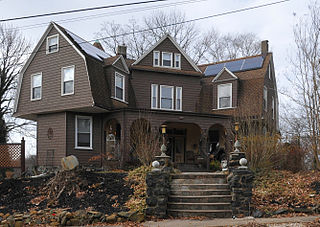
Windsor Hills Historic District is a national historic district in Baltimore, Maryland, United States. It is a cohesive residential suburb defined by rolling topography, winding, picturesque streets, stone garden walls, walks and private alley ways, early-20th century garden apartments, duplexes, and freestanding residences. Structures are predominantly of frame construction with locally quarried stone foundations. Windsor Hills developed over a period from about 1895 through 1929. The dominant styles include Shingle cottages, Dutch Colonial Revival houses, Foursquares, and Craftsman Bungalows.

The River Terrace Apartments is an apartment building located at 7700 East Jefferson Avenue in Detroit, Michigan. It was listed on the National Register of Historic Places in 2009. River Terrace Apartments was one of the first two garden apartment complexes built in Michigan which used loan guarantees from the Federal Housing Administration, the other being Hillcrest Village in East Lansing.

The community of Wyman Park is a border community that links Hampden to Roland Park. All of the Wyman Park areas were annexed to Baltimore City in 1888. The general boundaries consist of the area from south to north between 33rd Street and 40th Streets and west to east from Keswick Road to Wyman Park, which includes the southern portion of the Stony Run Trail. South of 40th Street, garden apartments, multi-story apartment buildings, and single-family residences have been built. People here tend to relate to the north along 40th Street and University Parkway and Johns Hopkins University.
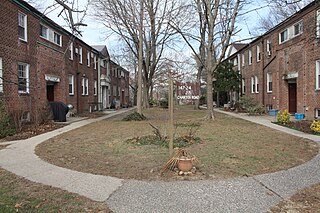
Parkway Village is a garden apartment complex with 675 residential units, located on 35 acres (14 ha) in the Briarwood section of Queens in New York City. It was completed in 1947 to house United Nations employees and delegates, many of whom had faced racial discrimination when they sought housing in other areas.
The Dundalk, Liberty, and Cornwall Gardens are a trio of historic apartment complexes on Dunmanway in Dundalk, Maryland. They consist of a total of 30 two-story brick Colonial Revival style buildings, which were built between 1937 and 1942, and contain garden-style apartments. Construction of the buildings was funded in part by grants from the Federal Housing Authority, whose principles guided the layout of the buildings to maximize natural light, and allow for the creation of car-free landscaped courtyards. As a result, the complexes also include separate garage buildings where residents could leave their cars. Each complex has features that distinguish it from the others.
























